/Uses - Vega Deftwing
July 23, 2023
Preface #
This is a uses page.
I want to preface everything by saying I am very fortunate to have all of the stuff I have. I like my stuff. But, ultimately, it’s just stuff. I know I do not use any of it to its maximum potential. It makes me happy to have it, but I also don’t need the vast, vast majority of it to accomplish the majority of what I want to accomplish. If you have less money, less stuff, then do not feel bad. It’s what you do with what you have that matters. I do a lot less with a lot more than some of the people that inspire me the most.
Ultimately, this is effectively a list of my toys.
Hardware #
Let’s just get the big picture first, starting with my main desk.
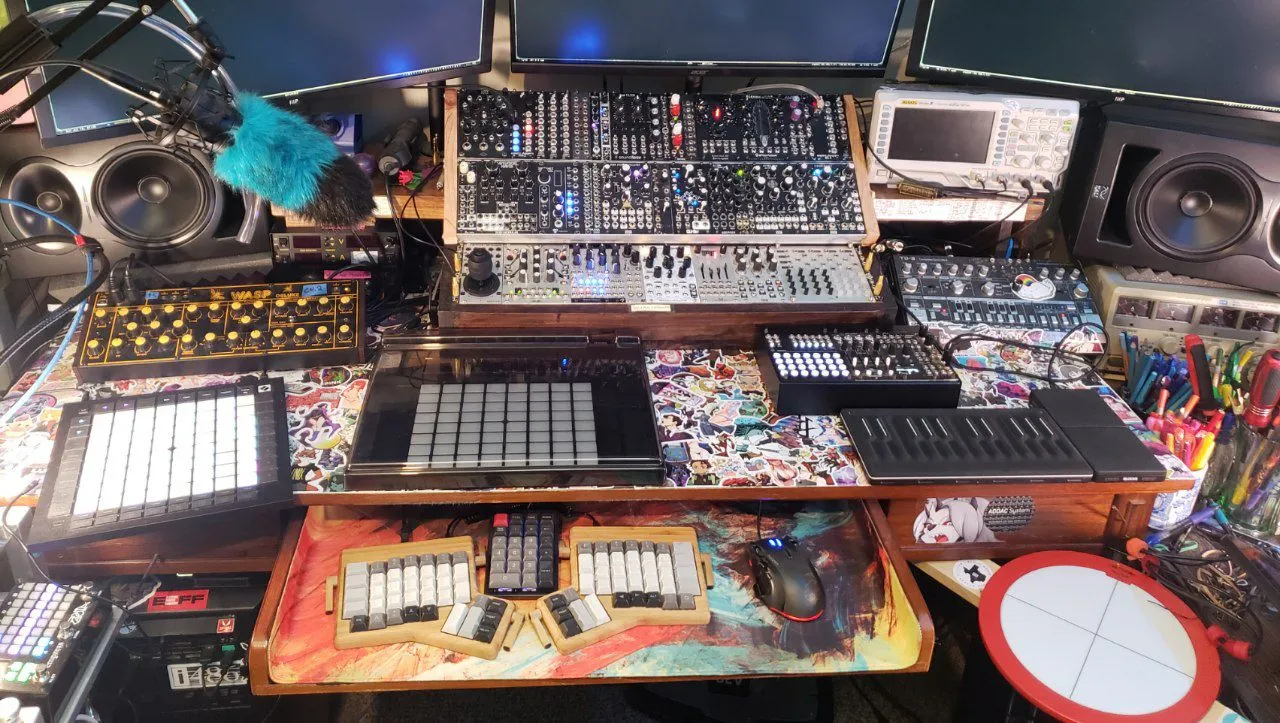
And on the left:
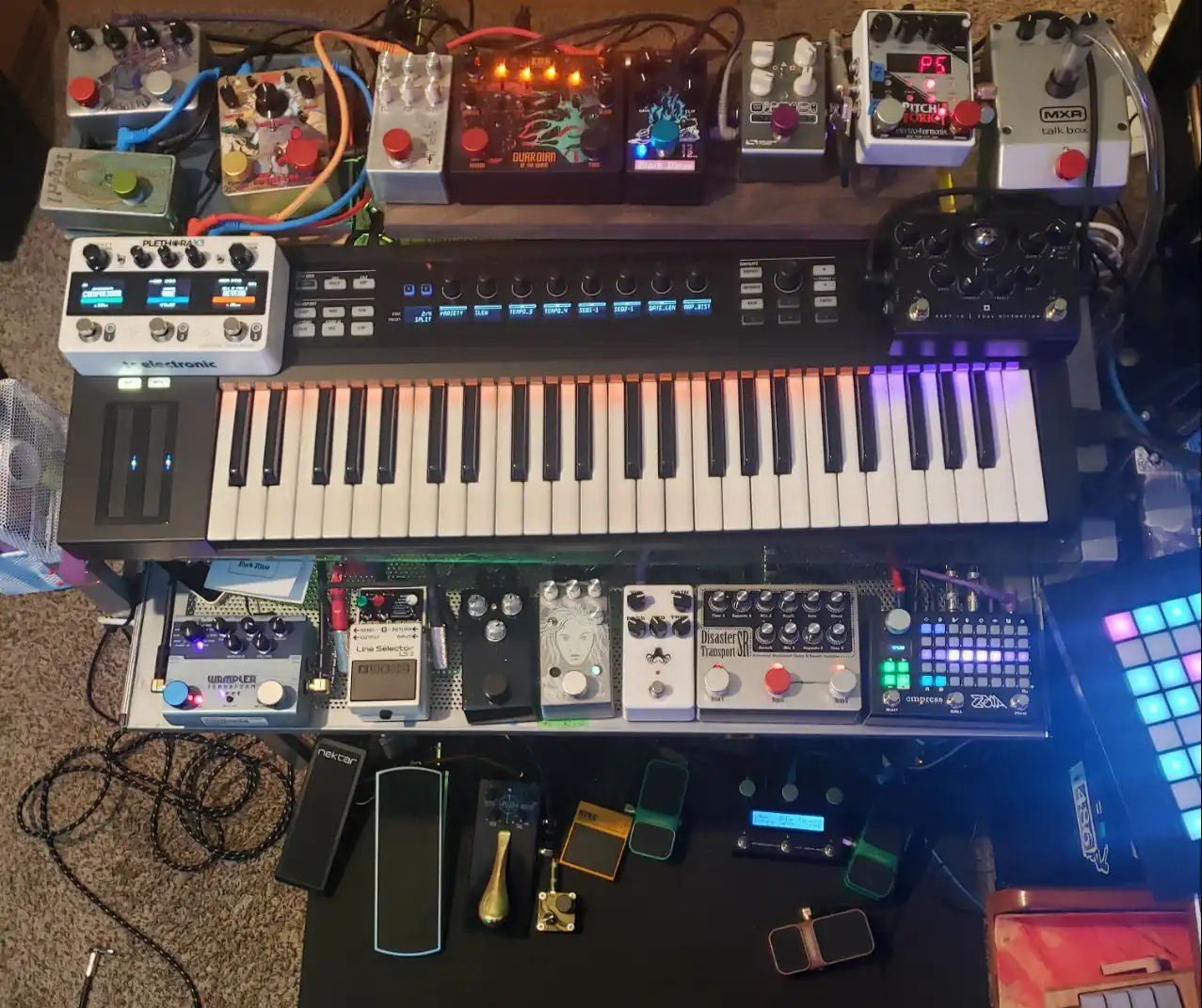
On the right is a sort of mini-desk. It has a fair amount of storage drawers holding electrical parts and is where my drawing tablet sits when not in use.
The PC + Accessories #
I’m going to skip over the detailed PC specs because you have what you have and can research what is the best price to performance based on your budget and work load.
Still, there are choices that mater at each price point.
I exclusively use full towers (ATX) because I like to throw a bunch of disks in there, have plenty of air flow, and have all the room in the world for putting in whatever expansion card I need. It also means more fans, which means lower fan speeds, which means less background noise.
For a case, this means something old school, with 5.25" and 3.25" bays to spare. In my case (pun intended) this is the Phanteks Enthoo Pro. This also allows me to use big ol’ air coolers which, in my experience, are more reliable, make less annoying noise (I really, really hate pump noise and bubble noise) and are less of a pain to get working correctly (I’m looking at you, NZXT, requiring software control).
For displays, I have a 3 x 4k setup. All 60Hz. All 27". All in one horizontal row for a glorious 11520×2160. Additionally, I have a cheap Monoprice drawing tablet. Do not buy a cheap Monoprice drawing tablet. The drivers suck.
To go with the Monoprice tablet, I have a BDN9 macropad with 7 switches and two encoders. I have this mapped to a plethora of function in Krita. Having physical knobs for some controls makes digital art much more enjoyable.
I also have an Oculus Quest2 that has 3D printed adapters to turn it into a “FrakenQuest” using the HTC Vive’s Audio Strap. I’m quite happy with this, though it does have some problems. Honestly, the worst part of the setup is Meta’s insistence on updates that frequently cause me issues and make me sign back in, taking hours every time I just want to play VRChat through SteamVR.
Rounding out the displays, I often play games with friends over a SteamLink connected to cheap projector.

I use an Ergodone, a clone of the Ergodox, with Kailh Box White switches. They feel similar-ish to Cherry Blues, but a bit chonkier. I’d like to get a nice SA profile keyset for it, but, $$$. I type in DVORAK instead of QWERTY. My keymap has lots of extra goodies to let me type a lot of unicode characters directly. I also have a numpad between the two halves for the very occasional Blender usage (not pictured)
My mouse at home is a Roccat Tyon. I love the lil’ fin on it and have a mapping that lets me very easily navigate and control i3WM when I’m in Linux. It’s also fantastic for gaming… mostly. The “analog stick” on the side is a legitimately useful idea, but occasionally it will make some games very determined to think you’re using a controller and not mouse + keyboard. Still, when it works it’s fantastic. At work I use an MX Master like everyone else, as well as an Ergodox with Cherry Browns, which is the loudest switch type my employer allows.
For game controllers I use a Steam Controller for anything where it wants to work and a cheap XBox controller when it complains.
I also have USB foot controller attached to my computer both at work and at home. At home I use a Stinky Footboard that I gutted and replaced the microcontroller in so that it runs QMK, like my keyboard. At work I only needed one extra key so I bought this pedal and threw a Raspberry Pi Pico in there running an HID device program. This is convenient because it shows up as a flash drive, making it easy to change what the pedals does compared to the pain of setting up QMK.
I use a Razer Kiyo Pro as my main webcam sitting atop my middle monitor. Aside from Razer’s insistence on installing their shitty software, it’s great.
Additionally, I have a PointGrey FL3 hooked up - it’s comically overkill, but I got three for free and they sure do look amazing. They do run extremely hot though.
The Music Gear #
I own a lot of music gear, so if you don’t care, I’d highly advise skipping this section.
Interface + Speakers + Mic + Headphones #
Central to any musicians gear, the audio interface. I’ve had the experience that most audio interfaces have at least some problems, and so don’t want to recommend anything. I use a Focusrite 18i20 2nd Gen, and it’s been mostly fine, but YMMV.
I will say Tascam’s are a no go - I had two high end Tascam units blow up in under a year. Similarly, it’s been my experience that most audio interfaces that don’t require external power have noise issues or are at least more prone to giving you noise issues with ground loops later. This is particularly frustrating, as most small interfaces are exclusively USB powered and so for those with limited space your options are limited.
Suffice it to say, I have a big interface from a decent brand and, importantly for my setup, it supports ADAT, which is necessary for using the Expert Sleepers ES-3 and ES-6 which are discussed below.
The same goes for studio monitors for the most part. I’ve very happy with the Kali Lp6’s I have, but you should do your own research and get what best fits your desk, budget, space, and neighbor’s tolerance for disturbance.
For a mic, I use the AT2020 like everyone else. I got tired of trying to get a vocal processing chain setup in software for voice calls though, so I got a used DBX 286S. Given my inability to sing, this is basically only used for voice chats.

For headphones, I almost always use the Beyerdynamic DT770’s. They’re not a million bucks, but sound great. If you pay attention to musicians on YouTube, you’ll probably see the same headphones atop most of their heads.
When I just want to listen and am in the mood for something really fun, I’ll bust out the Grado SR125’s which have enough impact in the percussion and a fun enough character to make rock sound really pump me up. My set is modified with removable cables and I’ve replaced some of the plastic bits with metal - adding to the weight a smidge, but dramatically improving my comfort in bringing them literally anywhere. The mods were pretty in depth though, and not something I’d recommend due to the high risk of breaking something. I’ve also had problems with hair getting through the mesh and stuck ratting next to the drivers, which is super annoying to fix.
Guitars #
I do a fair amount of music stuff and while I’d say I’m just as deep into synths as I am guitars, I still think of myself as more of a guitar guy than a synth guy.
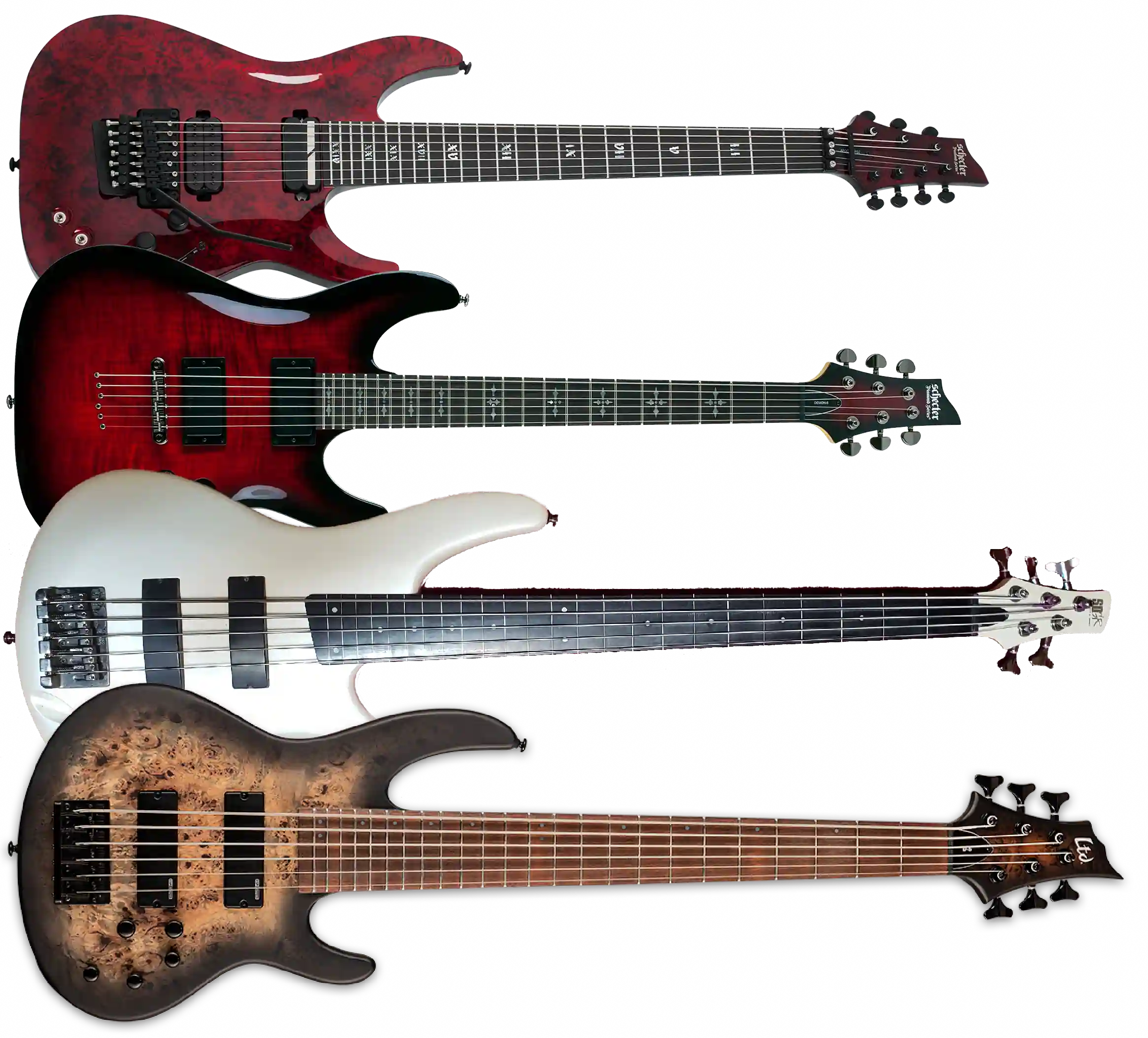
Schecter C-7 FR-S Apocalypse
This guitar is really, really kick ass, and I absolutely love how it feels to play. The neck profile, pickups, etc. are all spot on and it sounds amazing.
My only real complaint is that, occasionally, the electronics complain and I have to flip the sustainiac on for a moment upon first connecting it to get any output.
I also think I’m a bit less sold on the Floyd Rose system than I was when I got it. It does maintain its tuning better than anything else I’ve had, but it’s also a royal pain to tune in the first place, such that I think I’d just rather not. I’ve also gotten the chance to play some multiscale (fanned fret) guitars since getting this, and think I’d prefer that.
I definitely have my eye on a few multiscale 7 and 8 multiscale guitars that have less bells and whistles. Though it’ll almost certainly be another Schecter.
Schecter Demon 6
Ibanez SR305F
ESP D-6 Bass
I also occasionally play on my SO’s Fender Squire Strat if I’m desperately in need of single coil pickups. I frequently nab their Soundgear SR300E 4 string bass (Which is very, very similar to the above 5 string fretless). Of any bass I’ve played, it’s by far the most comfortable and fun to play and my god do the pickups sound way better than they have any right to, especially when set it’s “PowerTap” pickup setting. If I had to keep only one of the three basses between the three we have, it would be this one. It’s mind blowing to me that it has the lowest new price tag of the three.
Pedals #
The most important part of my pedal rig is the Power Supply. I learned the hard way that the necessity for isolated outputs is no joke and that all the super cheap (~$20) pedal power supplies are absolutely full of shit about being isolated. Having this supply made some of my pedals go from an unusable pit of noise to sounding fantastic.
The other thing to keep in mind about pedals is the order they’re in really, really matters. We are not talking your college into signals course where everything’s an LTI system. Everything from the impedance, voltage, and latency (if digital) of the pedals adds up to influence the sound.
I also want to mention that a handful of my pedals have been DIY’d from PCBs sold by https://www.pedalpcb.com which are clones of other pedal’s circuits. The ethics of this are questionable, but as most pedals today are derivative of other pedals on the market, I think it’s more-or-less okay, but your opinion may differ.
So, without further ado, here are my pedals In the order of the signal chain:
- EHX Pitch Fork+ + Cheap Expression Pedal
This pedal doesn’t have the same mojo as an analog octave up or down, but it more than makes up for it by being able to do other pitch shifting fun and more complex chords (add a perfect 5th up and an octave down at the same time? done.) With an expression pedal it’s a great tool for trying out some call-and-response song structures just by slamming your foot up and down. Of all the pedals on my board, this one might be the most fun to play with.
It doesn’t track great. It doesn’t talk standard MIDI without an expensive box I refuse to buy. When using USB to change settings it has bad noise. But I super do not care, because at the end of the day the synth sounds I can get out of it are epic, and it does auto wah better than anything else due to being able to use it’s pitch tracking instead of just enveloping.
I am hesitant to recommend it though, only because I think a guitar from https://jamstik.com or adding a MIDI pickup to any guitar may be a better bet, if you can make it work.
It’s a talk box. It’s awkward as hell, hard to make sound good, slimey and gross, cheesy sounding, and infinitely fun. I got this to add to my collection of tools that combat my complete inability to sing.
The only not shit volume pedal. I don’t do volume swells or actively use it when playing much but having it to control the volume in the middle of my multiple-distortion/drive/fuzz chain is really handy.
- BlackMass 1312 (RAT Clone)
Black Lives Mater. Trans Lives Matter. Having a kick ass distortion matters. This pedal supports all 3 causes … but is only a very, very slight improvement. Before this I had the Donner Dark Mouse which still sounds great at literally 1/6th the cost.
- Gamechanger Audio Plus Pedal + Wampler terraform in FX Loop
On one hand, the ability to sustain the guitar’s signal like a piano and have intuitive foot control over that is insane. On the other hand, without modulation it sounds like ass and it costs quite a bit. When I got this the Superego+ didn’t exist, and I still haven’t tried one, but I suspect that it would be 90% as good as the Plus + Terraform combo at under half the price.
The Terraform is connected to the Plus Pedal’s FX Loop to add modulation. This is overkill. I almost always leave it in the mode labeled “Dime” which is a chorus modeling the Dimension C pedal, but the flexibility in effects for the sustained signal is very handy.
- Earthquaker Disaster Transport Sr. + DIY Expression Pedal
I keep debating selling this because I can do a digital delay that sounds more-or-less the same in a million ways but, ultimately, that’s not the point. This pedal makes me try weird delays and textures I’d never think of using otherwise. Plus, I have it early enough in my chain that I can use it to shoegaze.
The Disaster Transport Sr. has multiple expression pedal inputs on the back. One of these can control the feedback. With a normal expression pedal, this would go from no feedback to well above unity. I wanted to be able to temporarily make it go to exactly unity, so I made a pedal that uses a momentary switch to do exactly unity gain (or whatever I dial the knob to) only as long it’s held. At unity gain it’ll sort of sustain the signal indefinitely, but in a way that is wildly different from what the Plus Pedal does.
- PedalPCB Duocast (Hudson Broadcast clone)
The Duocast was rather expensive and difficult to build, but it sounds absolutely fantastic. It just handles dynamics so well going from a clean-ish boost to a wall of fuzz by how hard you strum is like nothing else. I got this because I wanted to get some distortions that do a better job of reacting to dynamics.
- PedalPCB Mofeta (EAE Model feT clone)
Words can not do this pedal justice. It makes everything else on the board sound better. It’s the perfect preamp-y distortion-y amp-sim-y pedal. The real ModelFeT is a bit rich for my blood, and the DIY one is smaller. This was a tough build - I’m glad I’d done quite a few others (including the above Duocast) first, but it was oh so worth it.
It runs Linux.
Really though, it sounds pretty great. I’m using it mostly for chorus, vibrato, and it’s nice doubler effect (though never on all at once). This pedal serves as the point at which my pedal rig diverges into two different chains, so getting a bit of width before that point helps. As standalone pedal for smaller boards, I wouldn’t recommend this pedal. For boards like mine, acting as a one stop shop for modulation in the middle of the chain and doing stereoization, it’s great.
Coming off of one of the Plethora’s stero outs:
A Big Muff, but it doesn’t suck™. Seriously, it adds all the EQ, clean blend, and voicing options the BigMuff desperately needs. Did I mention clean blend? Clean. Blend. Every Muff should have clean blend.
- Dongeomac Green Ringer, rehoused
(The Green Ringer is what the Earthquaker Tentacle circuit is based on)
This pedal sounds great, but I didn’t love the pedal-in-an-outlet box build, so I moved it into a new case. The signal it puts out is a bit hot, and it’s best with a fuzz before it (hence the Chief Disruptor) but when given something to chew on it can do everything from add in a nice bit of high end to sound almost like a synthesizer.
A quite nice analog chorus and vibrato. I got this with a broken BBD chip and missing knobs for $20. Fixed those, and it sounds great. I do absolutely adore the sound, but I don’t know that it’d be worth the full new price.
- PedalPCB Cetus ( Victory V1 Kraken clone)
This pedal sort of sucks. It doesn’t sound nearly as good as the Broadcast or Mofeta, but it serves an important use on my board - it, roughly, adds the same EQ, response, and box-y sound as the Blackstar Dept. 10 Dual Distortion (which is the last pedal on the other side) … but worse? … I don’t know. Something about it isn’t just right. Still, it is helpful if I want to make both the channels (we’re post the stereo-split from the Plethora X3) sound similar with a nice realistic amp tone.
Unlike the other PedalPCB pedals on my board, I bought this one already built off of Reverb.
Coming off the other output of the Plethora:
It’s an HM2 on ‘roids with a perfectly tuned noise gate, better EQ, and clean blend and an FX loop to put something between the HM2 and the noise gate. It’s a lot of sound, so it needs to go into something that can work with that added spice in a good way.
- (In the FX Loop of the Wurm): Boss LS-2
- (In the FX Loop of the LS-2) PedalPCB Teddy Rupture (KMA Fuzzly Bear clone)
The Wurm sounds a lot better with just a bit of fuzz in it, so, I added a clone of KMA’s own Fuzzly Bear pedal. This pedal doesn’t have clean blend, so I run a Boss LM-2 between them, so that I can blend the Wurm’s output and the fuzz’s output as a wish. Since the Wrum can be clean blend’d, this means I can let some of the clean signal though too. It’s a bit annoying to dial in, but it sounds great.
The LS-2 is a bit expensive and bulky, but there’s not much better.
The Teddy Rupture was a super easy build and sounds perfect for its use case, giving me a nice analog octave up sound to complement the Green Ringer on the other side.
Amp + Cab sim with a real tube. Sounds good unless you plug in the USB cable. If you do, noise will destroy you. Does what it needs to do. I got it used for stupid cheap. It’s not worth the new price, but I also don’t really like any of the other amp/cab sim pedals, other than the Model feT.
Now joining the two chains back together:
At the end of the chain, merging everything back together, is the Zoia. This gives me a chance to do any effect I might want to in hardware to get the two different chains sounding cohesive again. Usually this is just a reverb, but because it’s basically a modular synth in a pedal, I can really go nuts. I really like being able to do insane modulated delays and verbs.
Eurorack #
Interfacing #
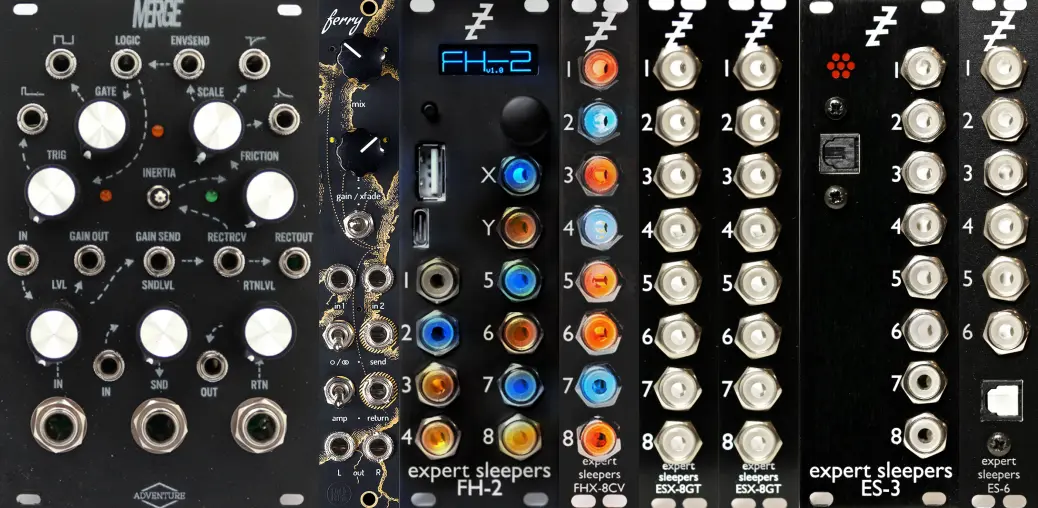
-
Adventure Audio Merge (Built DIY), Knob.farm Ferry
These modules have come as a side effect of various failed plans. Originally, I got the Adventure Audio Merge to run my guitar into my rack for processing. This was a failure. The noise floor from going from an instrument level signal to line level from pedals to eurorack level back to line level was intense, even with a good quality, isolated guitar pedal power supply.
Fortunately, the Merge is still quite handy for hooking up other instruments. I often use it to attach a Kalimba, contact mic, and an opened up hard drive which I can spin the platter on to act as a sort of physical oscillator.
The knob.farm Ferry I got for a similar purpose - I’d built a Monome Norns (which I really didn’t vibe with) - and had gotten this to allow it to interface with the Rack. I eventually sold the Norns, but the Ferry remains handy for attaching anything with a stereo output to pipe through the rack.
-
FH-2 + FHX-8CV + FHX-8GT + ESX-8GT
This is one of the defining features (or lack of) in my rack - I have no sequencers (unless you count the Maestro for modulation) but instead sequence everything via MIDI→CV conversion. I’ve done this for a few reasons.
- I want to have notes that can vary in length in my sequences.
- Most hardware sequences are either generative, or simpler than what I can sequence from a piano roll.
- I can sequence in hardware from my MIDI controllers anyway.
- This still can keep the note and gate sequences independent making the de-coupled note and gate sequences that makes eurorack cool still possible.
- I almost always want re-trigger on my envelopes, and the FH-2 can generate ADSR’s with retiggers, making it cheaper than dedicated ADSRs with retrigs
- I want to clock sync to my DAW
- This saves needing to wire up a quantizer to sequencers, further saving money/rack space
- I can still do micro-tonal or CV sequencing stuff though the ES-6 and ES-3 if necessary
-
These allow for outputting 8 signals (DAC) and taking in 6 signals (ADC), all DC coupled and at the normal eurorack levels. This means I can hook into VCV rack and output any oscilator, setup a send return to any effect, etc. This makes my rack and software all work together as one cohesive system.
Utilities #
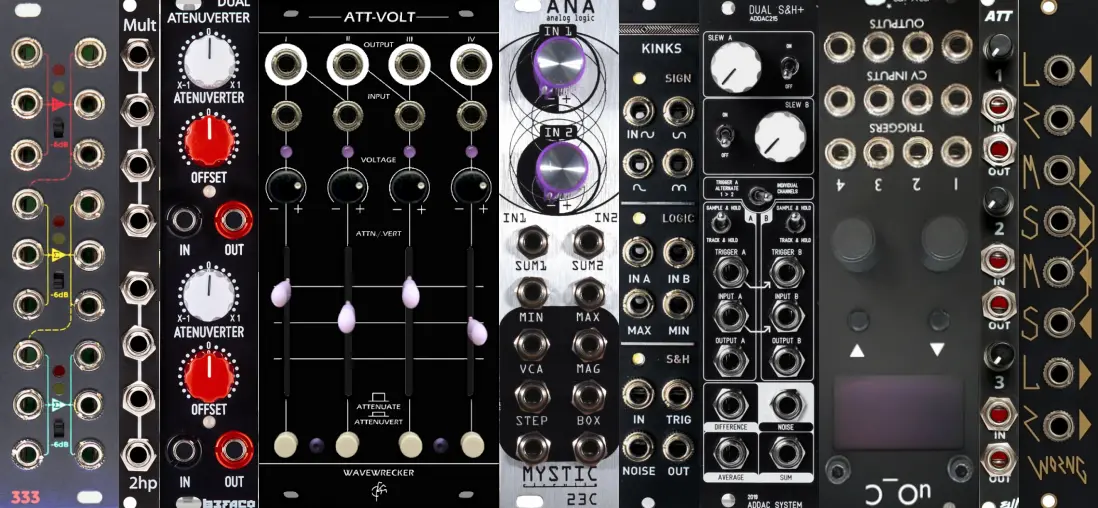
-
Great for distributing and mixing V/Oct signals.
-
unbuffered mults
I would normally advise against wasting rack space on unbuffered mults. I have them in my rack because I attach probes out to my oscilloscope to them so that I can easily look at any signal. I’ve debated replacing this with a Tymkrs Bulkhead
-
Befaco Dual AT(Bulit DIY), Wavewrecker ATT Volt
They attenuverters. Not much to say.
-
I mostly use this as a distortion, but it can be nice for making a bunch of different modulations.
-
Mutable Instruments Kinks (mine’s a clone)
Mine has a broken internal connection between the noise and S&H, but otherwise works fine. It’s a nice, multifunction module. Pairs nicely with the Maestro (mentioned below) for deriving new modulations from other inputs.
-
Also works as a slew in a pinch. Having T&H is great. Just a great utility. I particularly like hooking up my Joystick to it.
-
A do everything module. Super handy for when I need something I either didn’t splurge for a dedicate module for (quantizer, logic gates, burst, etc.) or when I run out of the nicer ones.
-
Triple Passive Attenuator
Mostly used for when I need to make a signal going to the ES-6 not clip.
-
mid-side encoder & decoder. This is really nice for making big, stereo synth sounds from two different modulated but same note waves.
I probably should’ve gotten one of the newer options that lets you add some width artificially, but I’m still happy with it.
Effects #
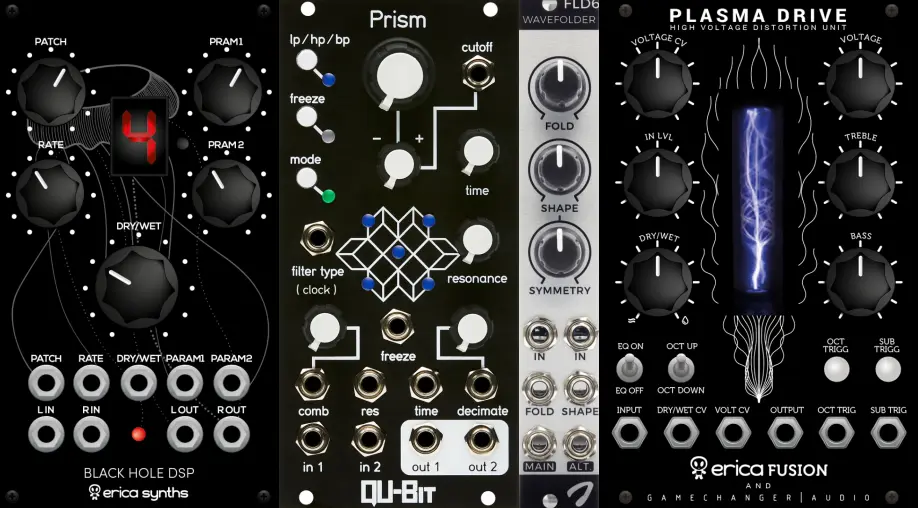
I need to have some in-rack effects because going from the rack to the PC and back multiple times makes latency correction a massive PITA. Plus, modulating effects with CV is fun.
-
The effects are… marginal. I eventually want to load in a Valhalla DSP fx card, but the mod to do that is expensive. Since it’s FV-1 based I’ve considered trying to salvage EEPROMs from guitar pedals to add effects… some day.
-
Sounds good. Easy to use. I just absolutely can not understand why either the left input isn’t normal’d to the right input and why there’s not something for making the effect on the left different from the right (different delay times, glitching, etc.). It’s not stereo, it’s dual mono with the same settings, and that feels like a massively missed opportunity. Still, It’s quite nice.
-
A small wave folder. If I could have a whole row of this wavefolder, I would. I heckin’ love wavefolders.
-
Erica Synths Plasma Driver
It’s… meh? It looks awesome, but the distortion sound itself is too much. Fortunately, the EQ and octave effects built into it make it useful again and it’s still just super fun to toy with even if I can’t actually get a useful sound out of it.
Oscillators #
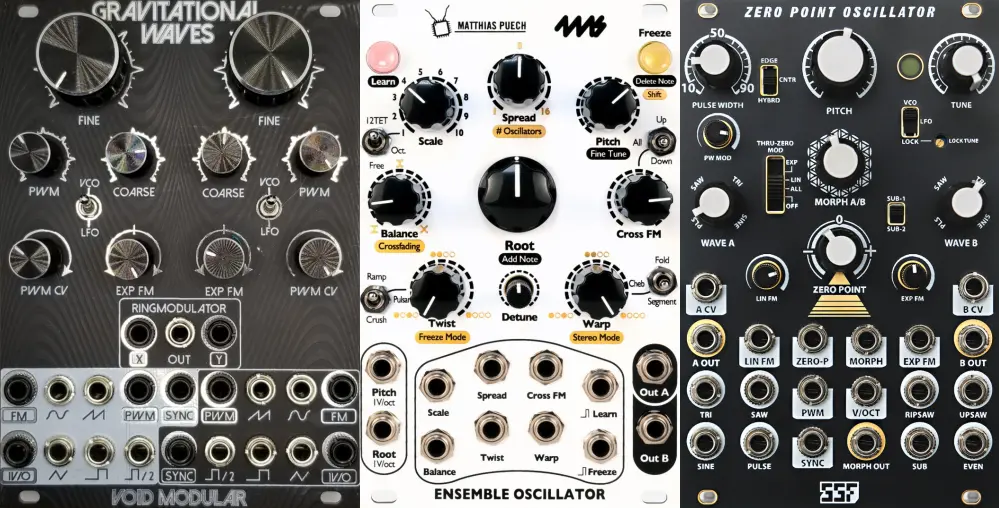
I mostly have analog oscillators and effects because otherwise I may as well just use VCV rack. The benefits to analog are in feedback patching and FM, so the two analog VCOs I have are centered around that idea.
-
Void Modular Gravitational Waves
Great sounding oscillator, doing fun FM stuff in a way only analog VCOs can do.
-
If you feed it a ton of modulation and are careful about tuning with the FM, you can get some crazy stuff out of this thing. As a basic oscilator, the control over the wave shape makes it fantastic.
-
The only digital oscillator. It’s basically the THX sound effect in a box, plus a lot more. I got it thinking it would be a way to sort of fake chords in eurorack, but it’s much more at home being treated as a complex, additive voice.
Percussion #
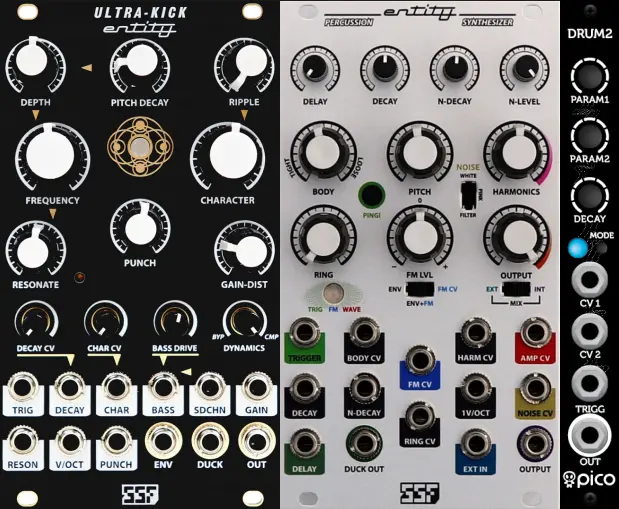
I tried very hard to avoid modular percussion for a long time. I mostly prefer the sound of acoustic kits, thought the price was absolutely stupid compared to using software synths, and didn’t see a huge reason I’d want to modulate my drums.
Then I got Knock for VCV Rack.
Then I got Prok Drums for VCV Rack.
And I was hooked. Unfortunately, Knock only really does a handful of sounds and the Prok modules eat my CPU, so, I decided I’d try real, modular percussion.
-
This one Fucks.
-
Super variable, usable for non-percussion sounds. Flexible and great sounding.
-
Erica Synth, I love this module, but fucking really? Aliasing? It’s a $5 uC with a few ADCs and a DAC. The value is in the software. It sounds fine in most modes, but at high frequencies the aliasing is super obvious and I expect better for the price. Still, in it’s normal operation it’s quite fun and it perfectly suits the role of adding a 3rd drum so I can have just enough drum kit for techno-y/EDM-y tracks.
VCAs + Mixers #
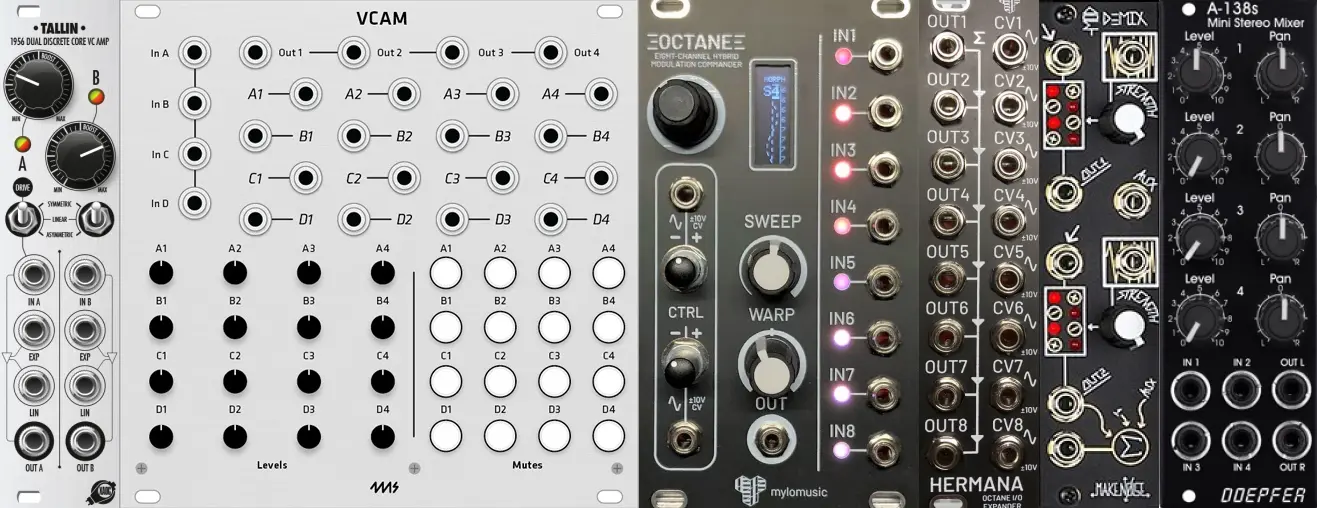
You can never have too many VCAs.
-
You can never have too many VCAs. It distorts nicely with multiple options for distortion.
-
Massive, a bit clunky, and oh so fun for feedback, mixing multiple waveforms, or doing FX sends.
-
Octane + Hermana
Made by a friend, this is a sequential switch / crossfader meets 8 VCA’s with crazy digital control. It’s nuts.
-
I basically use this as an extra VCA most of the time, but find doing the trick to ring mod a signal with itself to get an octave up effect nice occasionally. This was inexpensive used.
-
Doepfer A138: Mini Stereo Mixer
It’s a mixer. It’s cheap. It works.
Modulation #

-
For cheap, quick to dial in modulation, it’s perfect. (Ab)usable as an OSC for bass frequencies if you want to.
-
zlob Diode Chaos (Built DIY)
I like it, it’s cheap. My only complaint is that it’s not actually very chaotic at high speeds. Easy to build from a DIY kit.
-
This is really the “one of these is not like the others” of my rack. I have no sequencers and have plenty of modulation as well as outputs from the FH-2++, so why a joystick? Because it forces me to re-think creative choices and try new things I may not otherwise reach for. It also gives me a chance to introduce human control back into the synth.
The build quality is… weird.
-
For clock sync’d modulation, this is as hands on and deep as it gets. I do wish you could internally mix / do math on modulations to make more complex outputs, but the module is already about at the limits of comlpexity reasonable without having a screen.
-
After Later Audio Baker (MI Peaks clone)
The interface is way to cramped, but the functionality per hp can’t be beat.
-
It’s Maths. Anybody with a rack is legally obligated to own this module… for some reason. Honestly, I wish I’d gotten the Befaco Rampage instead, still, having the slew limiters alone is nice and not unreasonable for the money.
-
I haven’t really decided if I like this module yet, but the idea is that it’ll let me do ratchets and drum trigger effects easily.
Filters #
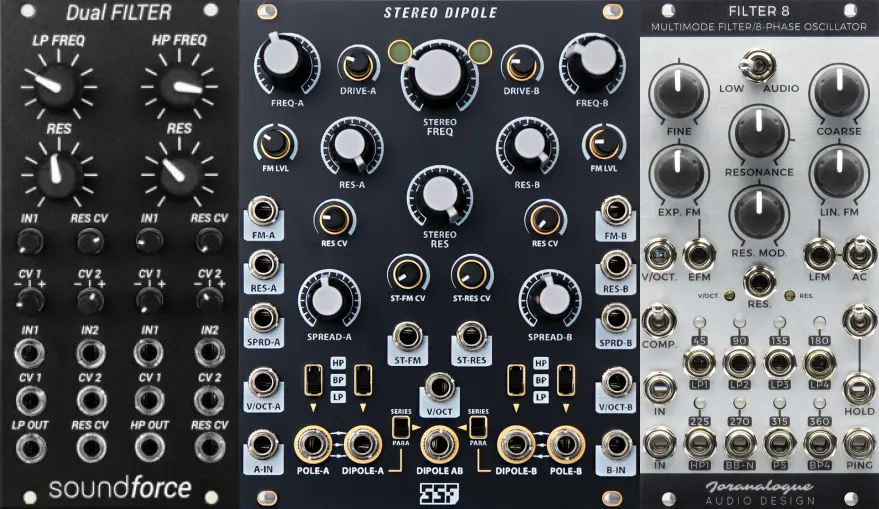
-
Lame low pass, kick ass high pass. It’s an MS-20 clone and is fun. It seems to me it self oscillates a bit to easily though. I’d like the resonance to get more aggressive before the self oscillation kicks in.
-
Nothing shapes sound with quite as much gusto as this filter. It doesn’t distort as much as a Wasp or the MS-20 style filter, but the multiple peaks and movment it can add more than makes up for it.
-
This thing is super smooth sounding, has some novel filter responses, modules great, and works as a great LFO or pluck in a pinch.
Standalone Synths #
-
As much as I hate Behringer, I couldn’t turn this down when the entire synth was on sale, new, for the same price as eurorack module that just has the Wasp’s filter. It has a certain retro yet aggressive vibe that I just can’t get with anything else.
-
Again, so cheap I couldn’t say no. I have multiple 303 emulation VSTs, but once I got done following the modding guide to do the sub oscillator, “rubber”, and filter tracking mods + the built in DS-1 style distortion, it hits better than any of the software does. I’d only recommend it if you intend to mod it though.
Behringer now sells a pre modded version with some of these changes, but some of how that came to be rubbed me the wrong way even more so than many of the other things they’ve done and I don’t actually think it sounds as good as the DIY mods.
MIDI Controllers #
-
This takes the award for product most in need of a display. Not being able to see the name of the scale you have selected or what CC your controlling, etc. is super annoying. Still, the pads feel nice, aftertouch works well. The sensitivity is just right for rapid arpeggios and hammering in leads and having a second grid controller so I can play two different synths at once works really nicely.
-
This is what made me stop using my Digitakt. If you’re an Ableton user but need something to let you enter sequences in a more tactile way, this is it.
-
Keith McMillen BopPad + drum sticks
Honestly, this is basically a toy to me. I’m not a good drummer. Still, having an interface I use with real sticks is nice for getting an idea of what rhythms feel good to play with drums sticks and so input things that feel more natural than what I gravitate to when trying to finger drum. This being MPE, having 4 quadrants so I only need one pad for 4 drums, and feeling good for the price all made it a reasonable purchase given my lack of skill.
-
Roli Seaboard Block + lightpad Blocks
I passionately hate Roli’s software. The way it wants stuff to run in the system tray drives me nuts. I also have an annoying amount of connection problems just getting Ableton to consistently agree its even connected…
all of that said, occasionally I’ll stumble into a fun bass line or morphing chord that I could only do on this or an MPE controller like it. For that, it makes it a vital tool to me.
If I didn’t already have the Seaboard Block and the Push3 had been out when I got my Push2, I would have just gotten the Push3 instead though.
-
An insanely configurable MIDI controller for your feet. I also have two expression pedals hooked up to it. This allows me to alter effects on the Zoia, Plethora X3, or on my computer without taking my hands off of my guitar.
Misc Music Tools #
In addition to the above, I have a few cheap and DIY musical devices
-
Kallimba (Thumb Piano): Fun to run though the eurorack
-
Shakers: For when I need something more convincing than a repeated sample
-
Harmonicas: For annoying my SO.
-
Hard Drive: Just the platter of a hard drive, motor connected to a 1/4" jack. Spin to make a signal. Sounds awesome processed though the modular.
-
Contact Mic: For making sound effects
-
Otomotome: For annoying my SO even more.
-
Reverb unit: I was given a rack mount reverb, the Lexicon MX300, and while I don’t normally use it, it’s nice to have for running the eurorack though and has a distinct, mid 2000’s character somehow.
The Failures #
-
Sounded decent, but, not good enough to justify its place. Space in the rack is expensive and limited.
-
Totally unusable.
-
Blue Lantern Braids (Clone of MI Braids)
Braids is a great module sound wise, but I really, really hated the menu diving. Plus, the Blue Lantern model had a wayyyyyy to bright 7-segment display. There was a dimming control in the firmware, but at low settings the PWM flicker was visible.
-
Aside from this being Behringer, which I try to avoid for personal, philosophical reasons (Yes, yes, there is no ethical consumption under capitalism, I know) I also found the patch panel to be so cramped that I frequently got frustrated trying to make connection and the panel to be quite ugly. It did sound fantastic, but the patch panel was bad enough that I finally got annoyed and sold it. I occasionally regret this.
As much as this sounds like a negative review, it’s actually anything but. I don’t think I would’ve delved deeper into Eurorack had I not had the Neutron as a stepping stone. The low(ish) price point makes it a fantastic choice for just getting your toes wet in modular.
-
Crappy latency and missed triggers. Almost everything else could be forgiven at the price point, but it needs to work consistently and not have uncomfortable latency.
-
I LOVE the Digitakt. Of any instrument I’ve ever owned, it’s probably the most fun, immediate, and enjoyable to just sit down and make loops on. It allows for sound design in a way nothing else I’ve used does, not even modular.
Unfortunately, it’s really good at loops and really bad at integrating with other tools. Even with Overbridge and an Ableton device to sequence patterns it still didn’t quite do it for me. I couldn’t get it to work with full songs, it allowed me to have fun making music, but I was left feeling a bit unfulfilled never making full tracks. I’m still bad at sitting down and doing that, but having gear that doesn’t fight me on it helps.
-
I think Sinesquares but it perfectly in their review,
It’s not that it’s bad or difficult to use, but the Model:Cycles has a very narrow palette of sounds and most of the stuff coming out of it sounds the same.
[…]
The controls tend to distort and make the sound a bit harsh that is definitely not for everyone or every genre so if you are looking for something more mellow and soft you end up using the exact same sounds every time.
If you have Ableton and M4L, https://opal.fors.fm is basically the Model:Cycles but better.
-
Novation Launchkey Mk2
Holy shit the keybed was god awful. Seriously, never, ever buy a MIDI keyboard without getting an idea of how the keys feel first.
-
Price to fun ratio wise, this is a great buy. I just found it awkward enough to use that I didn’t love it. Having a guitar with a sustainiac makes it less useful to me now anyway.
-
I got this as a gift. Twice. It’s absofuckinglutly useless.
-
Various Teenage Engineering Pocket Operators
These are… fine? I know some people make good music on them, but to actually be useful in a studio setting they desperately need MIDI. There are actually MIDI mods for them, but they’re quite expensive to the point where you may as well just get a better synth in the first place.
-
I really, really wanted to like the norns. It was so close to good, but the interface - even with a launchpad emulating a Grid64 - was … meh. It certainly wasn’t worth the cost, so I traded it for the Plasma Drive.
Now that the Teletype and a bunch of related modules have been ported to VCV Rack I’d be interested in getting it emulated on desktop… eventually ╮(─▽─)╭
Electrical Equipment #
Did you know it’s possible to hack the Rigol DS1054Z into a much nicer scope? Not that I’d ever condone violating DRM on professional equipment or that I would ever even consider doing such a thing myself!
I also have an “850D” soldering station. It comes in a dozen or so different variants if you google it and I can’t seem to find a link to my exact one - not that it matters, it’s pretty “meh” anyway. The power supply in it is effectively unusable due to not being current limited. But, it’s cheap and functional for soldering and hot air.
WH5000A a cheap multimeter that is fine for cheap multimeter needs.
The GPC-3020 is a dual output (+ a 3rd 5V fixed) Lab PSU that can be found for dirt cheap on eBay. It’s massive, overkill, and works great.
For RF tomfollery I have a HackRF One + Porta Pack. I actually have a LimeSDR (the original big one) too, but it has problems. Additionally, I have a cheap Baofeng. I am a licensed green eggs and ham.
I ordered a set of USB cable testers as designed by @alvaroprieto from JLCPCB and am kicking myself for not having something like it on hand years ago. I immediately throw away any shitty usb cables that are charge only or lie about their speed with the plastic color. I do not have the patience to try umpteen cables every damn time I want to plug something in!
Because I have some Dangerous Things in my hands, having a Proxmark3 Easy on hand (pun intended) has proven quite handy.
While most of my bigger parts live in those big arrays of slide-out plastic boxes, the small ones (resistors, transistors, diodes, most caps, etc.) live in antistatic bags inserted into baseball card sleeves in 3-ring binders. This is beautifully space efficient and by keeping things sorted by value it makes finding parts a breeze.
Misc #
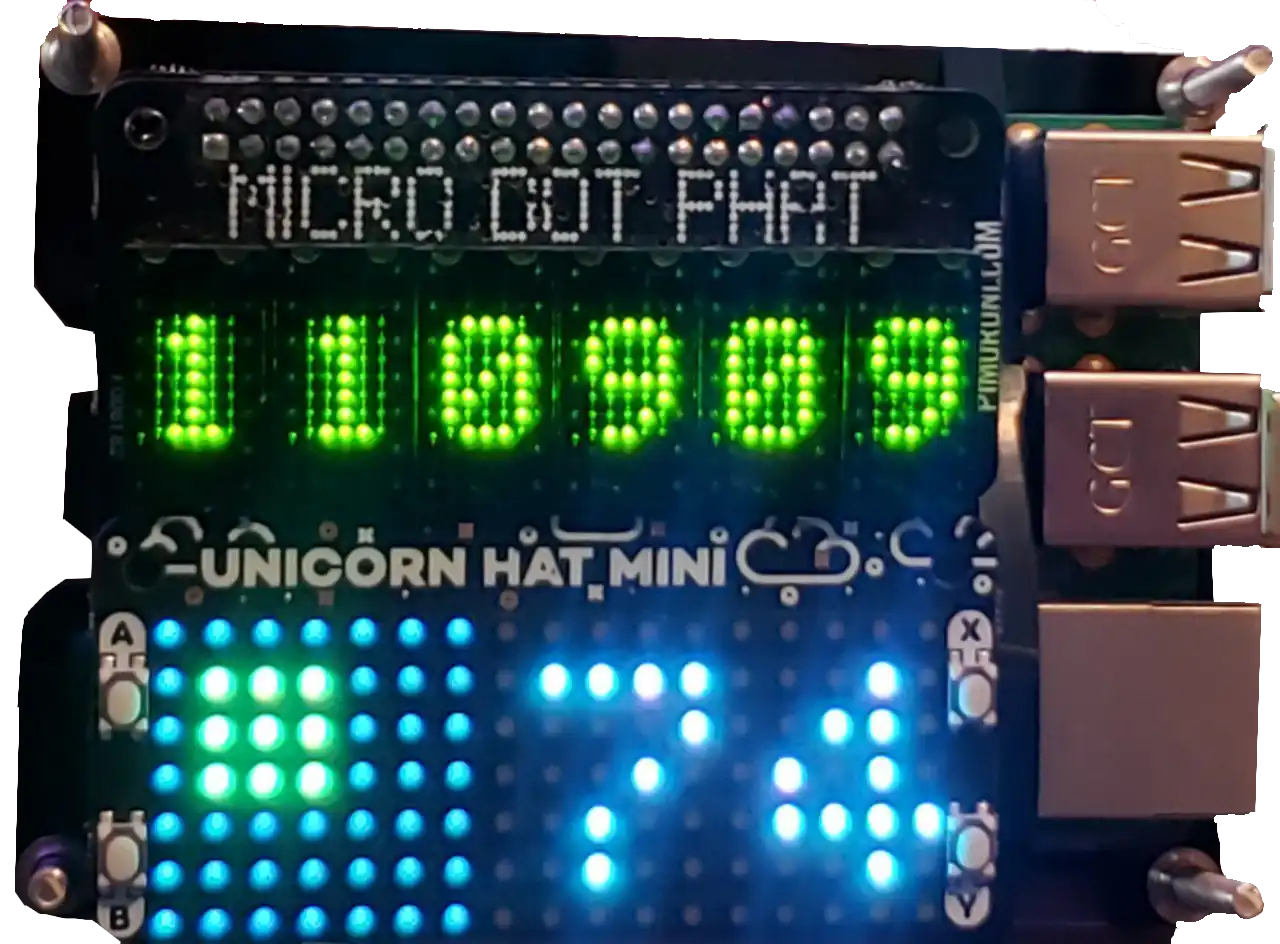
I also have a Nixie clock, but it’s in my bedroom because it emits so much RF crap that it can’t be in the same room as my guitars when recording!
Everyday Carry #
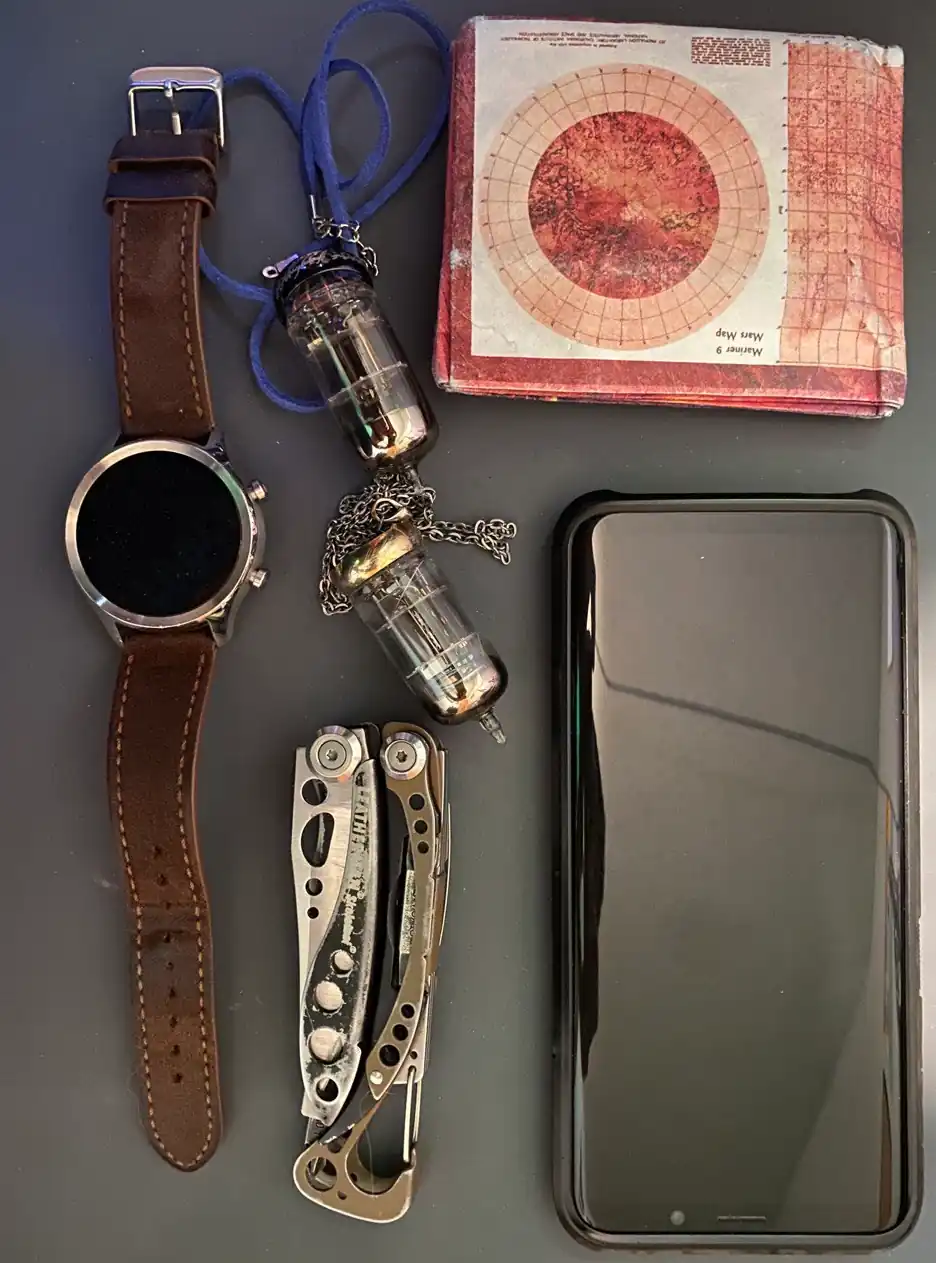
Samsung S9+
I really need to get a new phone since the S9+ has been EOL for over a year at the time of writing, but it does everything I need it to and it has a headphone jack - a feature I refuse to give up. I could root it, but that incurs a level of pain and time commitment that I don’t particularly want to deal with.
I saw the Asus ZenPhone 10 has a jack, and so that might happen ╮(─▽─)╭
TicWatch C2
It’s a generic, cheap Android Wear smart watch.
I mostly care about the heart rate sensor working since I have some health concerns there and this one has been less than reliable software wise. I used to care more about the watchface because I used Sectograph when in college for keeping track of when I needed to be to what class each day. As my schedule is infinitely more regular now, it’s not necessary so I’ll probably get something like the Garmin Forerunner 245 when I feel the need to upgrade due to the simplicity and battery life.
I do prefer a real leather strap though, and this one has served me well.
Letherman Skeletool
Tube Necklaces
Mighty Wallet
Clothes #
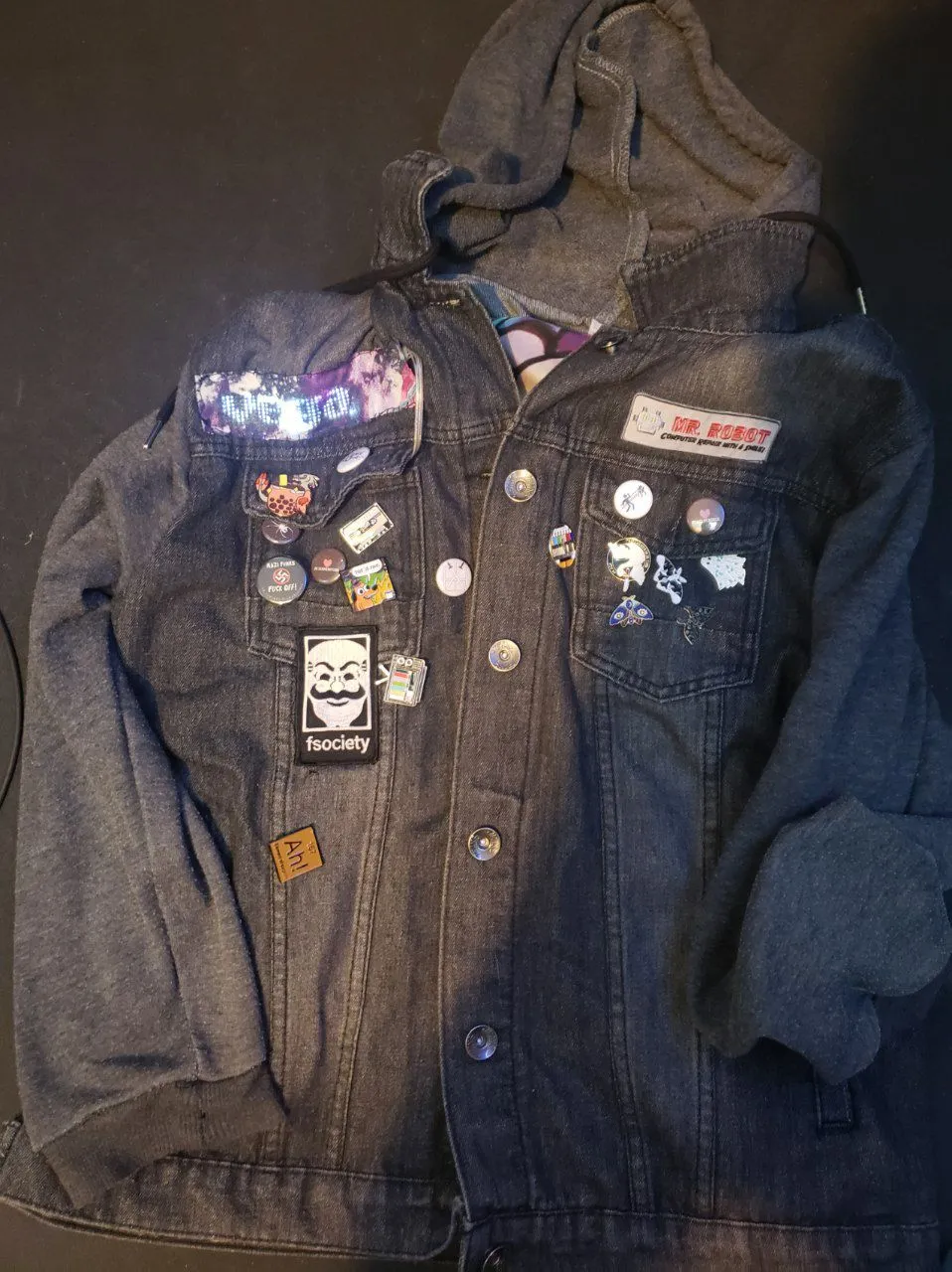
Software #
Before I get into the software list, I want to talk about the type of software I’ve struggled with the most over the years: Task management. I have tried
- Masterplan
- Condution
- Habitica
- Taskwarrior + taskwarrior-web
- obsidian.md
- do it tomorrow
- … and probably a dozen others I’m forgetting
Along with about every combination of the above and even just simple task lists or bullet journaling. They all ultimately end up not really working out for me. Some of the above worked for months or even years before falling into disuse for one reason or another that I don’t think can be attributed to simply lack of use. Some had broken functionality, some lacked a good UI for tracking process, etc.
Currently I’m back on the sub-optimal but easy solution of just spamming myself messages in my saved-messages chat with myself in Telegram. I do intend to at least go back to one of the above again, but I’m still not totally thrilled with any of the options.
Multi Platform #
Content Browsing #
- Web Browser: Vivaldi
- Homepage is https://github.com/tylervick/8bitdash
- Music:
- Streaming: Spotify
- Local: NCMPCPP + MPD
Office #
- Markdown: Typora
- I’m used to Typora after years of use, but really Obsidian will be better for the majority of users.
- General Office: LibreOffice
- Quick Pen Tablet Explainers: Xournal++
- I also did a large number of assignments in Xournal and printed them out in College.
- Semi-Quick Visual Documentation: Exclidraw or ASCIIflow Infinity
- PDFs: Sioyek for it’s wicked fast keyboard driven interface
- Text Epansion: Espanso
- KVM: Barrier
Communication #
- Telegram because that’s where all the furries are.
- There’s also some good “channels” in Telegram. For example, there’s a telegram bot for Hacker News that I use.
- Discord because that’s where all the voice chats are.
- Mastodon because that’s where I find the best inspiration.
- Gmail for most, Proton Mail for the important stuff.
Art #
- Image Compression: https://squoosh.app
- Raster Art: Krita
- Getting a headache: Blender
- I’ve also been toying with using some VR programs for sculpting
- Fighting with changing UI: Inkscape
Video #
- Recording: OBS
- Editing: Davinci Resolve
- Watching: VLC
Engineering + Development #
- Calculator: Speedcrunch
- Or my TI Nspire CAS
- Electrical CAD: KiCad
- Git: GitHub Desktop at home, Sublime Merge at work
- Editor: VSCode, like everyone else.
Linux Specific #
I mostly use Linux for development, writing, and web browsing. Depending on what I’m working on there’s a million different tools I’m familiar with enough to get the job done, but those really specific tools for one task you probably already know if you need and listing them all here doesn’t make as much sense as putting each on a better fitting page elsewhere on this website.
Desktop Environment #
I wouldn’t really call my setup “riced” (in part because I don’t like the term), but I think it would pretty much fit in on r/unixporn. I mostly like it because it’s stupid fast to use across many monitors and mostly keyboard driven.
Command Line #
- Terminal: Kitty
- Shell: Elvish
- I’ve been meaning to try xon.sh again. I actually like it the most of any shell I’ve tried for its ease of use, but last time I used it was very slow to load each time it was opened.
- Prompt: Starship
I also have a few commands aliased to nicer alternatives
ls→lsdcat→batdu→duffind→fd
Some CLI tools I frequently use that are a bit lesser known include:
bitwise: https://github.com/mellowcandle/bitwisesysz: https://github.com/joehillen/syszentr: https://github.com/eradman/entr
Though I also use ripgrep, pandoc, fzf etc just like every other Linux user.
I also use rsync for backups to a big ol USB DAS box with 2 4TB + 1 8TB HDD in it. I try to backup monthly, but really do so more like quarterly.
Graphical #
- Peek - for when loading OBS is overkill, but I need a quick GIF.
- Deepin-Screenshot - the least bad screenshot utility I can find
- Thunar - It’s a really fast to load and fast to use graphical file manager
Windows Specific #
I mostly used Windows for music production, gaming, and giving up on Discord’s shitty Linux client.
Music Software #
- Ableton Ableton is the least-bad option for me. FL has a much better piano roll, but lacks MPE support. Bitwig is missing a few QoL things. And, most importantly, with the Ableton Push, I have hardware integration that makes it the best feeling DAW to use - though the lock in hurts. If you don’t need MPE, get FL.
- VCV Rack I really enjoy modular, and VCV is all the fun at a fraction the cost. I got into VCV well before hardware modular and now see the two as almost entirely distinct tools. Note, VCV runs in Linux too, but getting (and keeping) Jack audio working for it to be low latency is a pain.
- KodeLife Not directly for music stuff, but I’ve been trying to get into video synthesis and I have a pretty nice shader setup in KodeLife that takes MIDI input.
- Synth V Studio Similar to Vocaloid. It’s really nice to be able to try out vocal lines and get them somewhat right before I try to copy them with my real, less than trained voice - and it’s good enough to just use a lot.
On top of this I use about a gajillion different VST plugins. There are a few I want to highlight as lesser known gems:
- (FREE) All of the Heckscaper Plugins
- Puremagnetik’s Octavlord is the best anlog-ish octave sound I’ve heard. Has just the right modulation baked in.
- Kuassa Efektor Ginia Preamps, and unlike NeuralDSP, they don’t use iLok and they’re priced well.
- (FREE) Lese Codec. Of all the digitial degradation plugins I’ve heard, this one sounds the best. It may not have all the knobs and dials of Digitalis, but man does it sound good.
I also use a variety of M4L devices for Ableton. Modulators 21, Opal, Mapul8tor, among others. I also occasionally make my own M4L devices for personal use - usually MIDI control surfaces, as lame as that is.
Seriously though, I have hundreds of plugins installed, I couldn’t possibly list them all here in a way that actually reflects what I use.
Art Software #
- Affinity Photo
Gaming #
I’m not going to list all my games or game stores, mod loaders, etc. I do want to mention a few trends though:
- Golf Gang, Golf With Friends, Golf It - all of these are mini golf games. My SO and I will play these with friend a few times a week. They’re brain dead enough that it’s possible to maintain fun conversations while still all keeping busy with a mutual focus.
- They’re all not terribly unfun even for anybody even when there’s a significant skill gap between different players.
- Risk of Rain 2, Noita, 20 Minutes Until Dawn, Hades, … - All rouge likes. As an adult with a billion interests and things to do, I like the lack of commitment that rouge likes offer makes me enjoy them a lot more.
Android Specific #
- Spectroid for trying to figure out what’s causing annoying hums
- Sectograph for it’s Android Wear watchface.
- WaveEdit for recording audio
- WifiAnalyzer
- Glitch Lab + Mirror Lab for having fun with photos
- Megalodon for Mastodon
This Website #
- Hugo static site generator
- Hugo Book Theme
- A bunch of JS utilities
- webmention.io
- I mostly do the writing in Typora
- I use Espanso to make writing the Hugo shortcodes less awful
- I use squoosh or
convertto make all the images .webp before uploading - Various spell checking tools that I don’t really use often enough. Most recently I threw vale.sh at the site and caught a bunch of duplicate words words.
If you’re interested in the other things I’ve tried along the way, check out How I make OpGuides .
Transportation #
I have two boards which I burnt lichtenberg figures into myself using an oil ignition transformer.
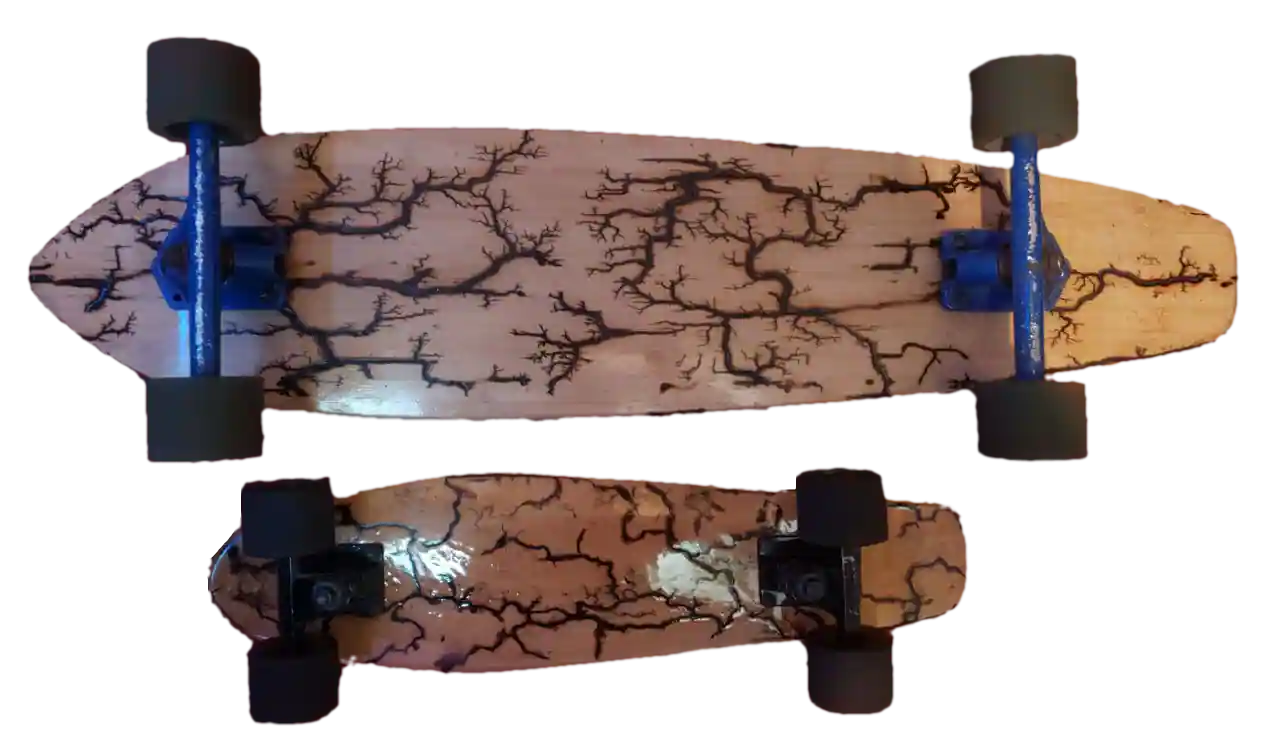
Speaking of high voltage burning,
DO NOT DO HIGH VOLTAGE BURNING.
Seriously. I cannot overstate how dangerous this is.
I burnt these boards myself. I have an electrical engineering degree and that, still, isn’t even the slightest bit of qualification to be doing this. Veterans with far more experience have been killed.
It is so dangerous, you cannot show off your work at professional woodworking events.
The plans to build these are only available on the internet because none could retail while passing common electrical safety standards. If you are an aspiring EE or maker, that sentence should strike terror into your heart.
It’s exceptionally stupid to even try this. It can and will kill you.
But I really want to though….
I’m not going to give you directions for this, sorry. But if you absolutely must, here are my tips:
- Use good high voltage testing and safety equipment. If you don’t know how to check that, or what ratings to look for when buying things, then don’t
- Make sure you’re using high voltage rated components, especially wire
- Fully understand the circuit diagram of the device you are using/building inside and out. That includes all of its failure modes and what can short or overload
- Stand a good ways away when you flip the switch. Watch from that distance
- Completely unplug it every time you go to move the contact points
But please, just don’t even.
I also drive a 2010 impala with 200k+ miles.
I mention this not because it’s interesting, but because I want to point out I don’t drive a very nice car. (Not that’s it bad, really). This is because I don’t travel much and would rather spend the money on other things.
Furniture #
Desk: I don’t know the particular desk model anymore, but I had a few features that were must haves that made finding it a real pain:
- A giant keyboard tray, big enough for a full size keyboard + mouse.
- Super deep - plenty of desk space for all the other hardware
- study - able to support a lot of weight of gear
Finding anything that meets goal 1. alone is a massive pain. I also have a cheap glass desk on my left for the pedals and MIDI keyboard and a DIY’d wooden mini-desk on my right.
Chair: From the start of 2020 to the time of writing I’d been using this chair which is a pretty generic, highly adjustable office chair. It lasted a long time and was quite comfy. In the middle of writing this post, I decided that chair, with it’s long torn up seat, has reached the end of its life. I’ve just switched to this chair which is less adjustable and, so far, not quite as comfortable - however, I bought it because the arm rests being able to fold up is an absolute game changer for playing guitar while sitting down at the computer.
Lights: The space I’m in has a skylight, but no permanent light fixtures. I’ve added an assortment of LED strips, bar lights, and a hanging bulb that are all smart lights and gave in and have an Amazon branded data collection device in the room for controlling them.
Tools #
Not much of note. I have the normal assortment of pliers, screwdrivers, hammers, snips, etc. The only notable tools are:
-
Picks
It’s weird to me having a good assortment of picks isn’t common, especially for anyone doing small electrical work.
-
Air blower
The electric, plug-in, type of thing that replaces using endless cans of air.
-
Creality Ender3
The same 3D printer everyone else uses. It’s… fine? I don’t really like to 3D print unless I have to because I dislike wasting plastic and 3D printed parts are generally not super durable unless you spring for expensive filaments, to the point where it’s almost always better to buy something off the shelf if possible. The “if possible” there is why I still have a 3D printer.
I’ve done a few upgrades to it: BL Touch, a lot of parts replaced with metal, etc.
-
Wire strippers
The automatic type. If you have to do hundreds of wires, using the manual kind gets old fast.
Misc. Failed Purchases #
-
LimeSDR
I’ve always had a mix of hardware and driver issues with my Lime, so it’s really just more of a very expensive lemon. I think I can get it working enough on at least one channel that I intend to use to feed a bunch of ADSB sources and let others access via a WebSDR platform. Eventually.
-
Various cheap guitars
Lots of cheap guitars are made nearly unplayable due to sharp frets cutting up the space between the thumb and pointer finger. Others just can’t hold tune. Not all cheap guitars are bad and not all expensive ones are good, but getting an actual name brand instead of Monoprice or the cheapest BS on Amazon will help a lot.
I also had a cheap, used 12 string guitar where the bridge literally flew off from the tension on the strings. I’m lucky that didn’t injure me.
-
Leap Motion
Looks cool on paper, effectively useless. I got it for some MIDI generating software that would basically make it super powered Theramin. It was neat, but not useful.
-
Kinect
I got two Kinects for free, one for XBox 360 and the other for the XBox One. I tried to use both for full body tracking in VR. This sometimes worked but was mostly just unusable.
-
Plotter w/ laser and pen plotting
I really, really hate dealing with any software that can make this work. At some point I need to reflash the 328p with a custom version of GRBL so I can get the pen plotter to even work again, since I can’t safely use the blue laser anyway.
-
Dell R910 + Powervault +++
I wanted to try my hand at somewhat high performance server stuff, so nabbed a massive server, a box ol’ DAS box, some SAS drives, some 10G mellanox card, etc. I learned a lot from doing this, but ultimately the power usage made it so I couldn’t justify running it long term.
-
2nd GPU for passthrough
I tried doing a Window-In-Linux system using Looking Glass to pass through the framebuffer. In the end everything did work, but the cost, complexity, maintenance burden, etc. just weren’t worth it. It also didn’t work for me because there wasn’t a good way (at when I tried it, back in ~2019) to mix the audio back into a single audio stream on the host and get high quality, real time audio input and output. I ended up using a hardware stereo audio mixer, but this had noise problems and was just generally a pain.
Dual booting as I do multiple times back and forth today is super annoying, but it’s less awful than that headache.